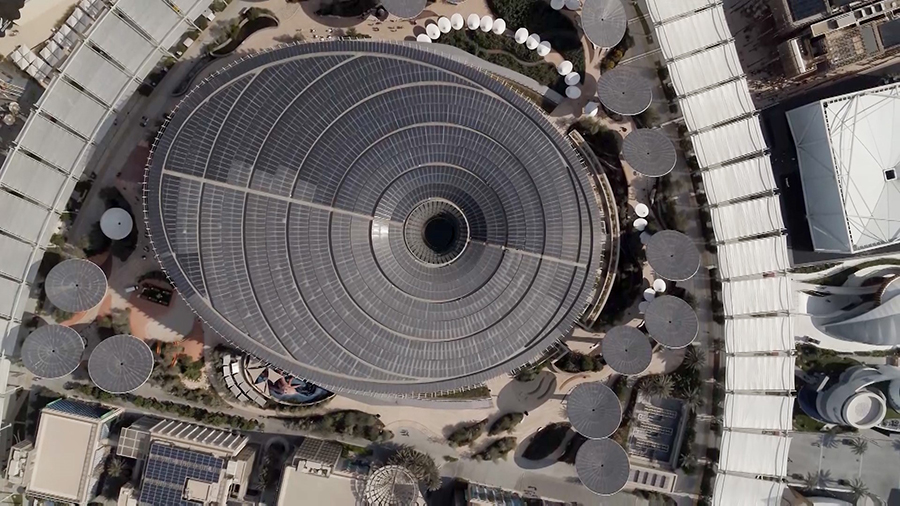On the latest episode of Eco Solutions, CNN’s Becky Anderson explores how the World Expo in Dubai is showcasing innovative ways to use the earth’s natural resources to help tackle the climate crisis.
The Terra Sustainability Pavilion at Expo 2020, is a place where countries have come together to display promising projects harnessing the power of the elements to create a more sustainable future. Sheena Khan, Education Lead at the Terra Sustainability Pavilion, speaks about the design of the building and her hope that it will set a precedent for future sustainable architecture, "Terra’s a LEED Platinum-certified building, which means that it has been designed and constructed to the highest levels of environmental sustainability standards. She’s also net-zero energy and net-zero water, which means you’re looking at a building that truly practices what it preaches."
Terra’s main power source is the sun, with the pavilion generating 4 gigawatts of solar power per year. Khan explains why solar power was chosen, "Sustainability is a global problem, but the solutions need to be local. So, here in the UAE, it really made sense for us to focus the majority of our technologies around solar because what we have in beautiful abundance here in the UAE is sunlight."
As well as solar power innovation, many countries are displaying developments in hydropower. In the Austrian Pavilion, CNN meets Harald Jursitzky, Managing Director of Powerfluxx, a buoy designed to harness the energy from rivers. Jursitzky says it’s the only hydropower solution that doesn’t damage wildlife habitats or harm water quality, "The main reason we don’t harm the fish is that our turbine wheel rotates very, very slowly. It’s a slow running engine which was also the technological challenge to convert this slow rotational speed into energy."
Coming up with new ideas and creatives ways to use organic, renewable materials is imperative for a sustainable future. Brothers Max and Allen Mohammadi are developing an alternative to plastic, creating single-use items like bags and cups from agricultural waste. At the Swedish Pavilion, Max explains why plastic is a big issue, "Plastic pollution is a systematic problem. Half of all the plastic that has ever been made, has been made in the past 15 years. That is a crazy trend, and if we don’t do anything now, it will be too late by tomorrow."
Another innovator using natural materials to change consumption habits is Costa Rican pallet producer Ignacio Barrientos, founder of Bamboo Pallet. The packaging industry uses huge numbers of trees, and Barrientos hopes to replace this reliance on wood with more sustainable bamboo pallets. He tells CNN, "The reason that we choose bamboo is because bamboo is a super sustainable raw material, it grows super fast. And also because of the carbon footprint, because these bamboo capture six times more CO2 than a primary forest, so this is also important for us."
Wind power is another key resource, with the power generated from wind making up a quarter of all renewable energy production. In the German Pavilion, Enerkite is displaying its wind harnessing technology, that it says has the potential to harvest more wind energy than traditional windmills. The company uses kites which capture kinetic energy. Co-founder Alexander Bormann describes the idea, "We were inspired by kiteboarders, who show in front of our eyes how they can convert easily the wind energy into mechanical energy. And we came to the conclusion that that can be a concept to replace wind turbines."
Finally, the programme meets Sébastien Bougon, founder and chairman of Flying Whales. Bougon has designed airships which he hopes will be used to deliver cargo, in a sustainable alternative to shipping or aviation freight. The airships are planned to be 150m long and able to carry 60 tons of cargo, with test flights beginning in 2024. In the French Pavilion, Bougon speaks about the reduced environmental impact airships could have, "We can operate everywhere in the world. We don’t need any infrastructure at ground. We don’t need ports. We don’t need roads. We don’t need anything. This airship is floating, using very few energy means. So no emission, no footprint on the ground. We are developing a cargo solution with a very, very small environmental footprint."
Eco Solutions sees how inventors and innovators from around the world are rethinking renewable energy and exploring methods to sustainably power the planet.



